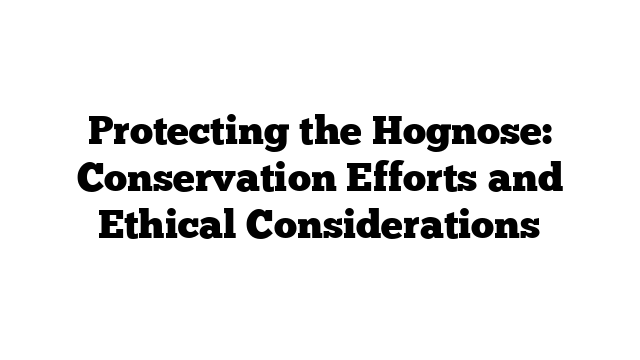Introduction
The hognose snake, belonging to the Heterodon genus, is a fascinating and unique reptile known for its upturned snout and distinct behavioral characteristics. While hognose snakes are widely loved by reptile enthusiasts, their populations in the wild face various threats, leading to concerns about their conservation status. This article will explore the ongoing conservation efforts aimed at protecting hognose snakes and discuss the ethical considerations involved in preserving their habitats and ensuring their survival in a changing world.
Overview of Hognose Snakes
Hognose snakes are found in North America, with three main species recognized: Eastern Hognose Snake (Heterodon platirhinos), Western Hognose Snake (Heterodon nasicus), and Southern Hognose Snake (Heterodon simus). These snakes have thick bodies, keeled scales, and are known for their defense mechanisms, such as playing dead and hissing loudly. Hognose snakes primarily feed on small rodents, toads, and other amphibians, contributing to the natural balance of ecosystems they inhabit.
Conservation Challenges
Hognose snakes face numerous threats to their survival, primarily due to habitat loss and degradation caused by human activities. Urbanization, agriculture, and the development of infrastructure fragment and destroy their natural habitats, making it difficult for these snakes to find adequate food, shelter, and suitable breeding grounds. Additionally, the collection and trade of hognose snakes for the pet industry have led to unsustainable harvesting practices and potential impacts on wild populations.
Southern Hognose Snake Conservation Efforts
The Southern Hognose Snake, one of the rarest snakes in North America, has recently gained attention for its inclusion on the list of endangered species. Conservation organizations and wildlife agencies have been working diligently to increase and restore populations of Southern Hognose Snakes through various strategies. These efforts include habitat restoration, captive breeding programs, public education and awareness campaigns, and the establishment of protected areas. The goal is to ensure sustainable populations of these snakes in their natural habitats and prevent their extinction.
Eastern Hognose Snake Conservation Status and Concerns
While Eastern Hognose Snakes are currently listed as “special concern” in New York State, their conservation status varies depending on their specific geographic location. Eastern Hognose Snakes rely on open sandy habitats for nesting, making the conservation of inland sand barrens crucial for their survival. Management efforts focus on preserving and restoring these habitats, reducing habitat fragmentation, and minimizing human disturbance in key breeding areas.
Ethical Considerations in Hognose Snake Conservation
Conserving hognose snakes and their habitats raises important ethical considerations. These include the moral responsibility to protect and preserve biodiversity, the potential impact of human activities on wildlife populations, and the role of the pet trade in hognose snake conservation. It is crucial to strike a balance between the interests of conservation and animal welfare, ensuring that efforts to protect hognose snakes are both effective and ethical.
One key ethical consideration revolves around the pet trade. While many reptile enthusiasts are passionate about hognose snakes and keep them as pets, it is important to ensure that the sourcing and trade of these snakes are done sustainably and responsibly. Strict regulations, proper permits, and wildlife protection laws help prevent the illegal trade and overexploitation of hognose snakes from the wild. Encouraging captive breeding programs and promoting education on responsible pet ownership can minimize the negative impact of the pet trade on wild populations.
Another ethical concern lies in the preservation of natural habitats. Protecting the habitats of hognose snakes not only ensures their survival but also maintains the integrity of ecosystems and protects other species that rely on these habitats. Conserving habitats may require making difficult decisions, such as limiting human activities in sensitive areas, implementing land-use policies that prioritize wildlife conservation, and finding a balance between economic development and environmental protection.
Conclusion
Conserving hognose snakes and their habitats is crucial to maintaining the biodiversity and ecological balance in North America. Ongoing efforts to protect hognose snakes, such as habitat restoration, captive breeding programs, and public education campaigns, play a vital role in their conservation. Ethical considerations, including responsible pet ownership and the preservation of natural habitats, further enhance these conservation efforts. By recognizing the importance of ethical considerations and implementing responsible conservation practices, we can ensure the long-term survival of hognose snakes and promote the well-being of both these fascinating reptiles and the ecosystems they inhabit.
